What Is as on Art Next to Artists Name
vii important things to know virtually artist signatures
Holly Blackness consults Christie'south specialists, a conservator, a gallerist and an expert cataloguer on the truths an artist's mark can reveal, the insights they offer into procedure and why — sometimes — a false signature can conceal noble intentions
- 1
Artist signatures kickoff became prevalent during the early Renaissance, which saw art product shift from branch guild systems to a celebration of individual creativity. A signature was the perfect way to differentiate your talent from that of bottom peers.
In the instance of Albrecht Dürer, whose famed monogram featured prominently on everything from printed masterpieces to hurried sketches, his 'AD' trademark (to a higher place) was then popular that he went to courtroom in both Nuremberg and Venice in a successful bid to protect his authorship, resulting in the subsequent proliferation of copycat prints labelled 'after Dürer'.
- 2
'I've worked with artists who use signatures equally a note to themselves,' says Sid Motion, who works with emerging contemporary artists at her eponymous gallery. 'Information technology's a mode of maxim, "That piece is complete, don't rework information technology". It's an honest, personal mark that stops them endlessly returning to a piece.'
Signatures are also commonly used to proceed a record of time, place and medium, as much as they are a signifier of a completed work. 'Ben Nicholson recorded a wealth of information on the back of his boards,' says Rachel Hidderley, Christie's Senior Director of Modern British and Irish gaelic Art. 'He not only signed, titled and dated his piece of work, but sometimes even listed the colours he used, or the accost of where he would exist sending the work on to.'
- 3
'There's no end to the variety of signatures an individual might apply,' according to John Castagno, an creative person and renowned practiced who has produced 17 reference books cataloguing artist signatures throughout history, as well as offer a full consultation service to museums, galleries and collectors.
'My commencement volume contained more than 10,000 entries,' he explains, 'with many artists using symbols and variations on their proper name. James McNeill Whistler had many different styles [he was well known for his utilize of a butterfly motif not just in his art, but as well in his personal correspondence]. In other cases marks are virtually completely illegible, such equally those of Jean-Michel Basquiat. He had two script signatures that were most impossible to read, forth with his printed version.'
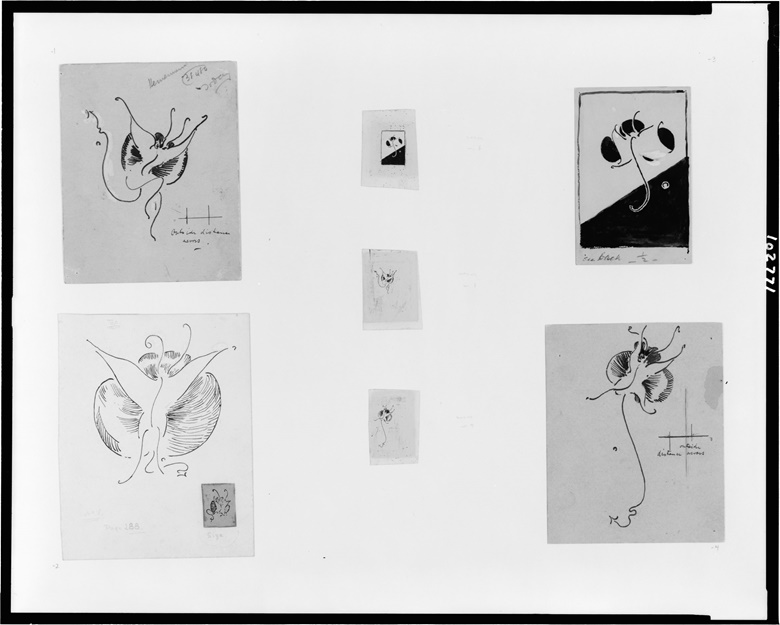
James McNeill Whistler (1834-1903), Butterfly designs, 1890-99. Seven drawings, pen and ink, white pigment, and graphite, with four photomechanical print reproductions
Although these variations might seem confusing, they can actually be very useful when it comes to dating a work. 'Picasso is a great case,' says Christie's Impressionist and Modern Art specialist Allegra Bettini. 'In his early career he signed including his middle proper name equally P R (or Ruiz) Picasso, later dropping the initial and developing a more decorative version.
'During his analytical Cubist menses he stopped signing the fronts of his canvases entirely in social club not to detract from the fine art itself, whereas later on he adopted his famous signature, consummate with an underlining dash. This was as well used as a symbol of completion.'
- iv
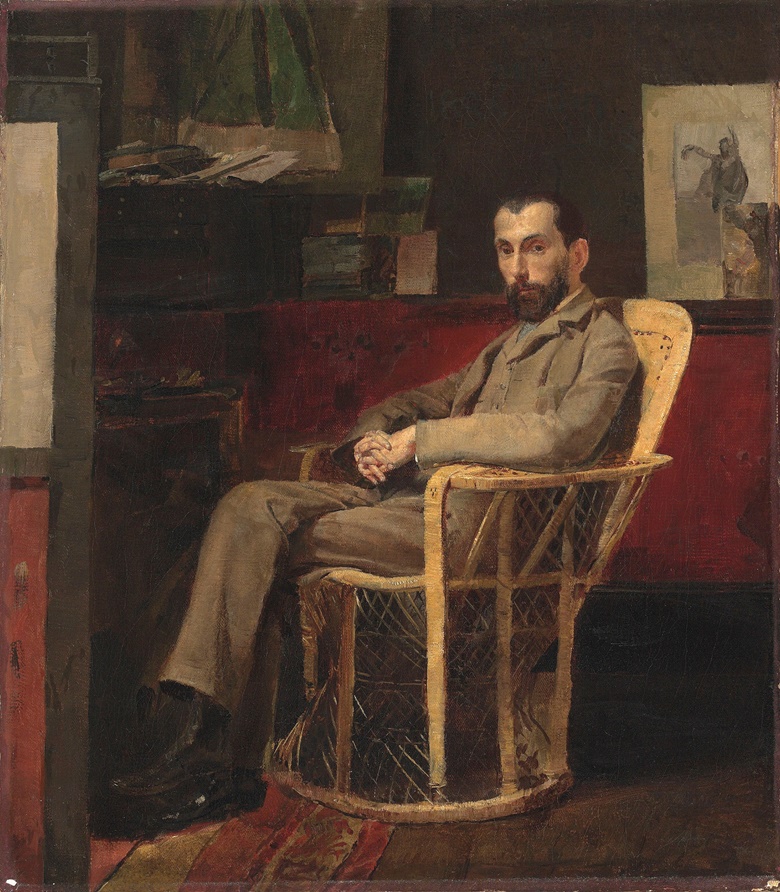
Thomas (Tom) William Roberts (1856-1931), Portrait of Louis Abrahams. Indistinctly signed, dedicated and dated 'Tom Roberts / for / friend / Don Luis / 1886' (in a higher place the sitter's caput). Oil on sheet. xvi x 14 in (twoscore.6 ten 35.half dozen cm). Sold for £314,500 on 24 September 2015 at Christie's in London
Uncovering hidden signatures can reveal a wealth of information lost during the passage of time. In 2015, Christie's Australian Art section discovered a subconscious signature and inscription by the Australian Impressionist Tom Roberts.
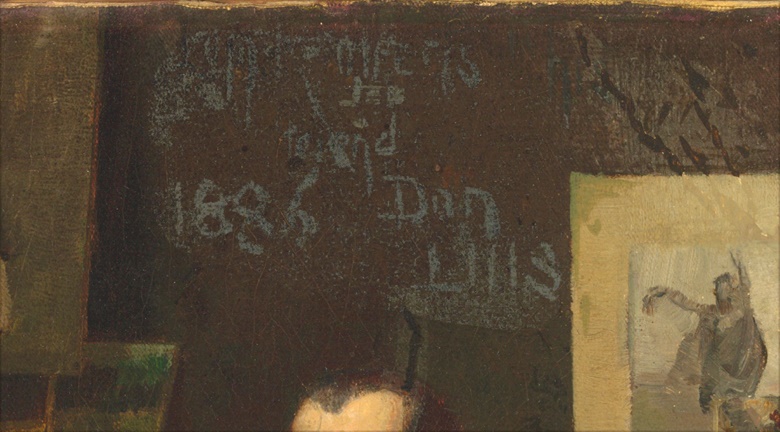
Detail showing the signature, from Thomas (Tom) William Roberts (1856-1931), Portrait of Louis Abrahams. Indistinctly signed, dedicated and dated 'Tom Roberts / for / friend / Don Luis / 1886' (above the sitter's head). Oil on canvas. 16 10 14 in (40.6 x 35.6 cm). Sold for £314,500 on 24 September 2015 at Christie's in London
'When studying the portrait of Louis Abraham at that place was no visible signature,' recalls Caput of Sale Amanda Fuller. 'Just every bit we moved the work around under the light, something defenseless our eye. We had the work photographed and asked our digital studio to raise the image, and in doing so they were able to reveal a dedication from the artist to the sitter, signed and dated, in the background. Information technology was a great moment, as this confirmed our suspicion that the piece of work was indeed painted by Tom Roberts.'
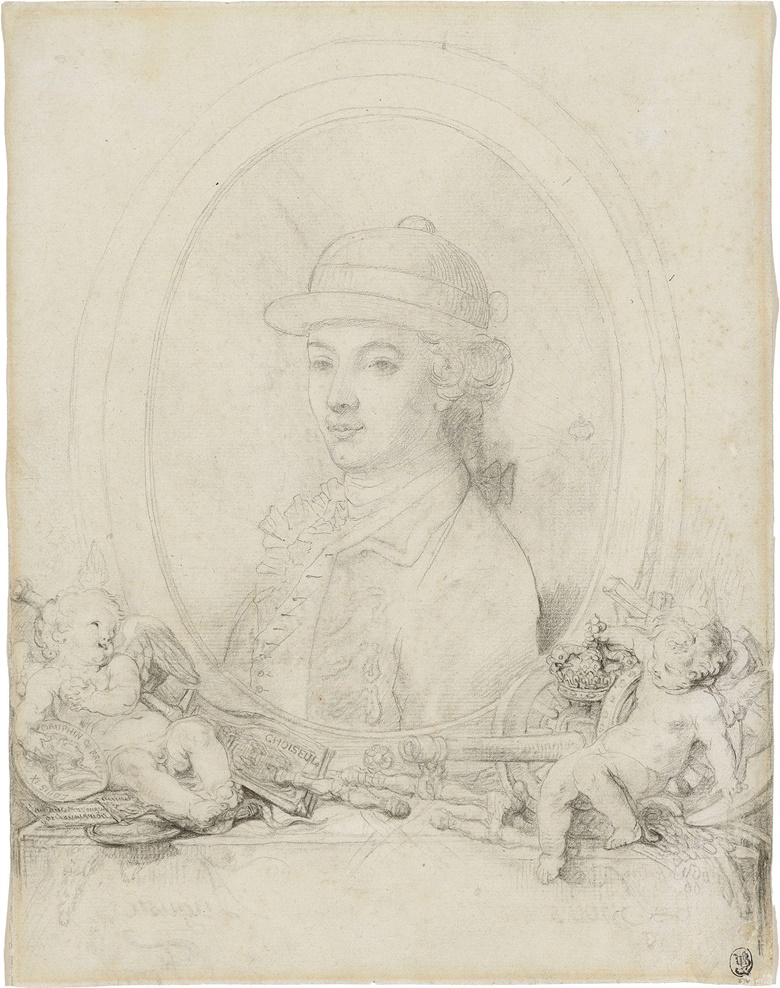
Gabriel-Jacques de Saint-Aubin, Portrait of Male monarch Louis Xvi as Dauphin. Inscribed 'Louis IX Dauphin de French republic / au duc de La Vauguyon / CHOISEUL' and indistinctly inscribed at the ledge 'Louis Auguste' (in opposite). Blackness chalk and pencil, watermark crowned fleur-de-lys with a countermark K. ten⅞ x viii½ in (27.7 x 21.vi cm). Sold for £viii,225 in The Dr Anton C.R. Dreesmann Drove Sometime Master Pictures in 2002 at Christie's in London
An even more than unusual case is that of a drawing by Gabriel-Jacques de Saint-Aubin, whose portrait of Rex Louis 16 was mistakenly considered to draw a woman, until about 2002. 'Funnily enough, when I was cataloguing this work a few weeks ago I actually realised that "Louis Auguste" was written in reverse at the ledge,' says Associate Specialist Jonathan den Otter. 'It looks as though no one had noticed this in the by 250 years! It's written in the artist'south typical handwriting, and so it proves both the attribution and the identity of the sitter.'
- v
Although signatures can ostend well-founded inquiry, they can likewise be misleading. An upcoming lot in The Former Kamerbeek Collection auction briefly featured a spurious autograph by Bernardus Johannes Blommers, hiding the true identity of its creator, the Dutch painter Jozef Israëls.
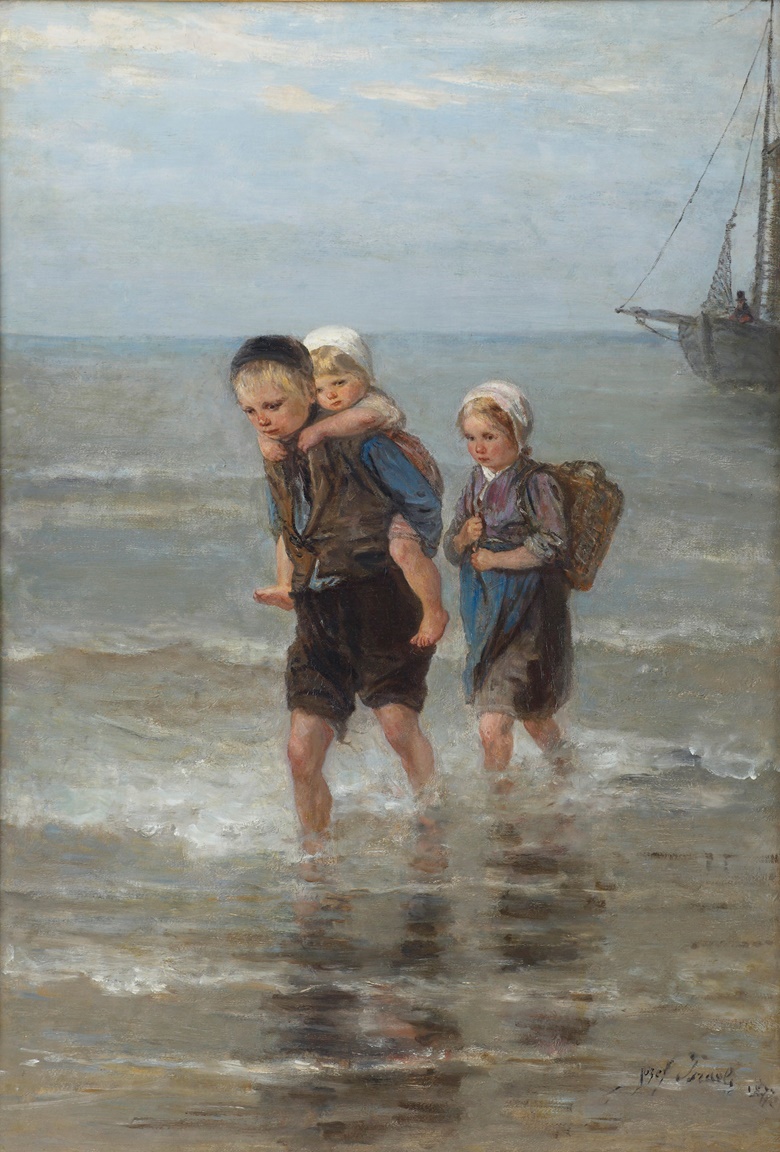
Jozef Israëls (1824-1911), Children in the Breakers, 1877. Signed and dated 'Jozef Israels 1877' (lower right). Oil on sail. 77.v x 53.five cm. Sold for €31,250 in The Former Kamerbeek Collection on 12 June 2017 at Christie'due south in Amsterdam
The painting was probably doctored during the 2nd World State of war in social club to obscure the fact that the artist was Jewish, and to relieve his work from being confiscated or destroyed. Afterward its provenance was questioned in 2003 the real signature was uncovered in the bottom correct-hand side of the piece, and the false version was removed.
- 6
'Added signatures are a fundamental issue on the market,' says Tom Rooth, Director of the Victorian & British Impressionist Pictures Department at Christie'south. 'They tend to fall into one of two camps. Either a painting has been created to imitate an artist's piece of work, together with a mimicked signature, or someone might add together a signature to a film at a later engagement, in order to deceive, and increase value — sometimes significantly.
'Information technology is by and large fairly easy to observe both,' Rooth explains. 'There is oft a concentration in execution, and a slower, more deliberate way is apparent that you wouldn't wait from someone signing their own name; faked signatures often lack fluidity. Later on seeing numerous works signed by an artist, yous also develop a familiarity with how they sign and inscribe. Of class you can likewise put the painting under a UV light. If the signature has been added at a later date, the difference in pigment volition show up past flaring.'
Rooth too looks out for artists who might accept minimal signatures. 'Myles Birket Foster was an exceptional watercolourist, merely his monogram was very simple. This has made him bonny to forgers who recall they can replicate the simple 'BF' — although imitating the infrequent manus and brushstrokes of a maestro is significantly harder to get away with, to say the to the lowest degree.'
- 7
When because whether to invest in a work of art it is important to know whether an artist normally autographs their piece of work. 'If you have the pick it is ever wise to favour signed over unsigned examples,' advises Rachel Hidderley. 'However information technology is crucial to recollect that some artists — such every bit Stanley Spencer or Christopher Wood — never signed anything. And so it pays to recall that sometimes you won't find a signature at all, and nor would yous desire to.'
In research terms a signature is always one piece in a larger puzzle. 'When nosotros showtime see a work of art, of course the inscription is something we will have into consideration,' says Angelica Pediconi, a fine art conservator and art historian who has worked with international dealers, collectors and institutions including the National Gallery. 'Often something might be obscured due to oxidation, and then if we uncover anything nosotros are conscientious to examine it under a microscope.
'Yous accept to look at the craquelure [the network of cracks that develops every bit pigment layers historic period and compress] to see if it matches the panel or sail,' she continues, 'or work out whether information technology has been retouched. When we brand a discovery nosotros are careful to transcribe our findings and consult with the owner. Nevertheless, signatures are just one part of what we wait for in our research. Everything you need is in the painting itself — you just need the heart.'
Source: https://www.christies.com/features/7-things-to-know-about-artist-signatures-8365-1.aspx
0 Response to "What Is as on Art Next to Artists Name"
Post a Comment